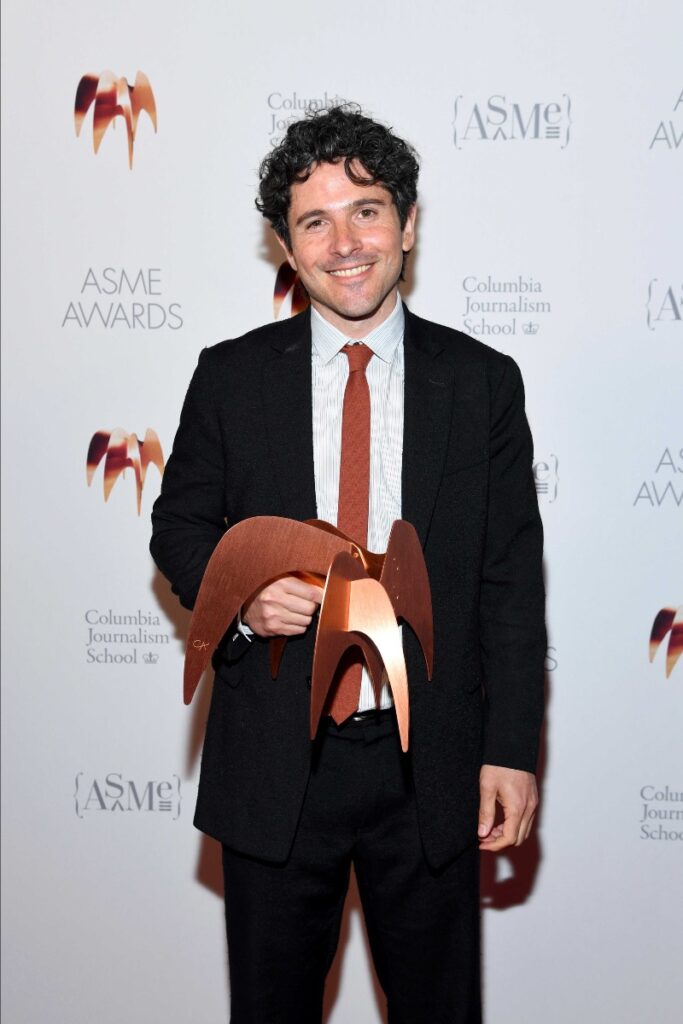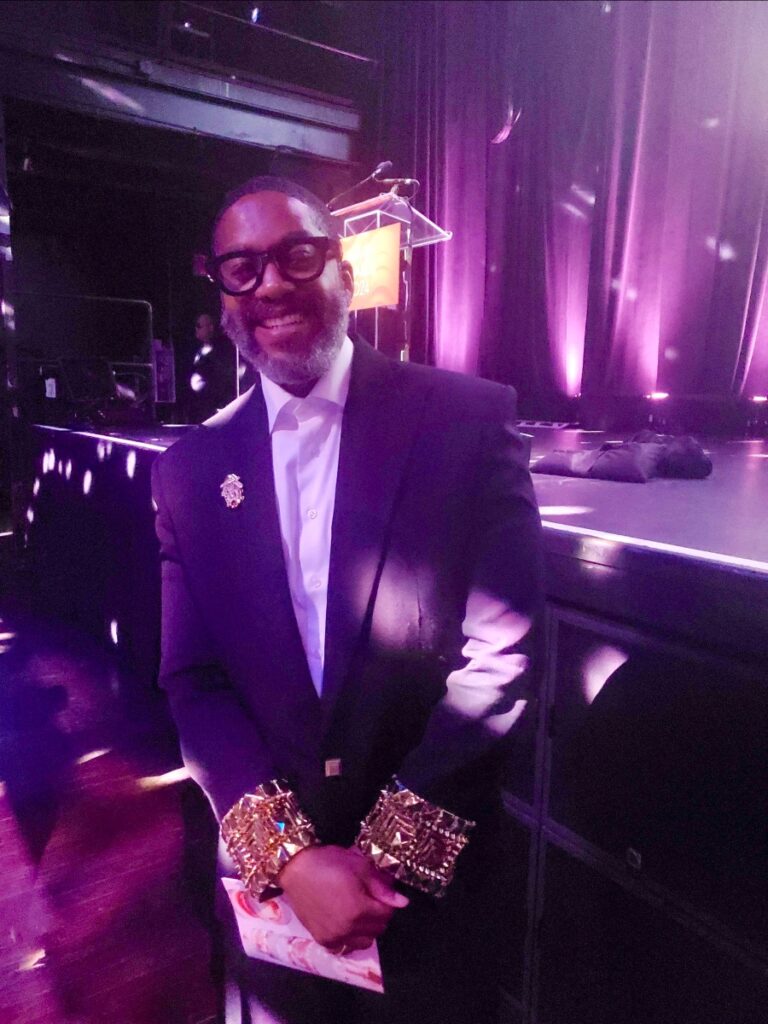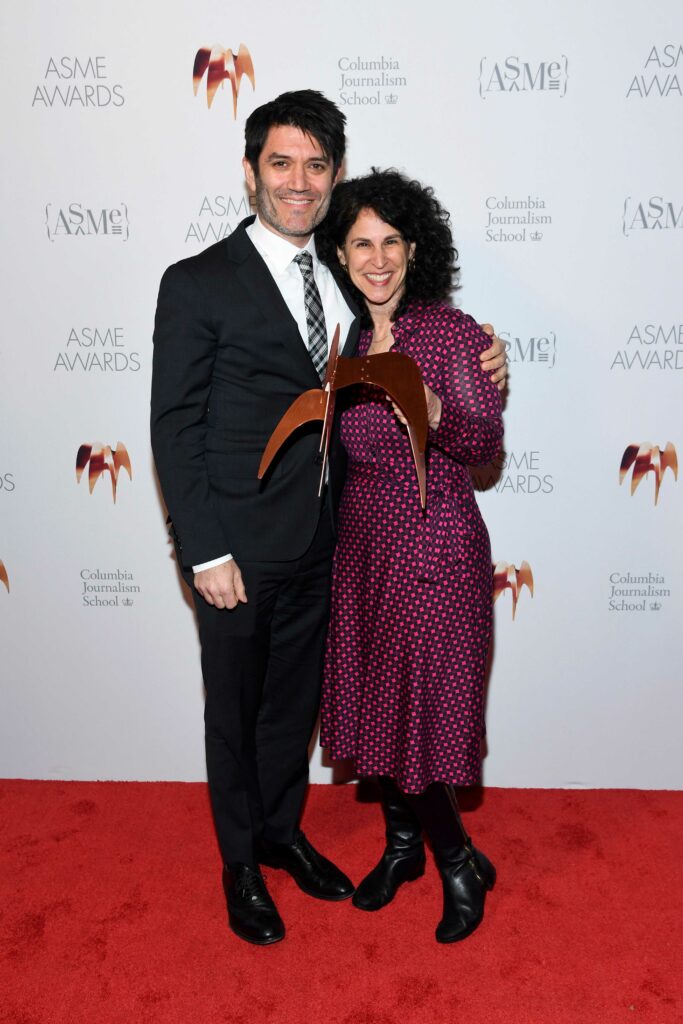Ellies on Parade
Basking in the glory: Jake Silverstein, Jay Kirk, Amanda Kludt, Clara Jeffery, Sid Holt, David Haskell, Mitchell S. Jackson, Willa Bennett, Nicholas Carlson, Susan Chira, Jeffrey Goldberg, Meghan O’Rourke, Sophie Schmidt, Nicholas Thompson, Anna Wintour, David Remnick (who may want to rewatch On the Waterfront) and many, many more…
Tensions surfaced at the National Magazine Awards ceremony last year when then New York Times Magazine staff writer Jazmine Hughes told the crowd, “I’m really happy to have this award, and this will look really good next to the disciplinary letter I got the other day.” This year, there was just as much elation, but the disagreements and upsets, sharper than ever, remained largely subterranean.
OUT AND ABOUT
The National Magazine Awards were back at Terminal 5, for the second year in a row, on Tuesday, April 2. The de jure signature cocktail was the Party Lobster, a combination of Rosaluna mezcal, Campari, watermelon, lime, and habanero. The celebrating crustacean was a suitable enough mascot in that attendees were essentially underwater, but the de facto cocktail of the night, judging by the long line of writers and editors shaking out their umbrellas and selves on arrival, might have been called the Wet Dog: equal parts rain, suspense, Hell’s Kitchen street muck, shaggy excitement, and business attire. Like any drink of unsuspected strength, the Wet Dog got in the way of some attendees’ socializing. “The rain made it so hard to get over here, and then the bar line was so long, I haven’t actually bumped into anyone,” New York Times Magazine editor-in-chief Jake Silverstein told The Fine Print just before the show got rolling. “I was waiting in line for a drink when I heard the bell ring.”
Features writing finalist Jay Kirk — who later won the category for his harrowing Times Magazine storyabout the Sandy Hook crime-scene investigators — looked around for competitor William T. Vollmann. “He’s a God, he’s a trip,” Kirk mused. “Maybe he’d show up with a bunch of prostitutes.” Vollmann was nowhere to be seen, but prominent in the slightly soggy crowd were American Society of Magazine Editors board president and Vox group publisher of Eater, PopSugar, Thrillist, and Punch Amanda Kludt and her predecessor, Mother Jones editor-in-chief Clara Jeffery. “I’m sure Amanda will do a way better job than I did,” said Jeffery. “I’m so relieved. I don’t have to get up there again? Awesome.”
Surrounding them were former college roommates ASME executive director Sid Holt and Harper’spresident and publisher John “Rick” MacArthur, Vox Media president Pam Wasserstein and CEO Jim Bankoff, New York editor-in-chief and single topic issue and photography category winner David Haskell, New York city editor and veteran ASME application writer Christopher Bonanos, The Verge editor-in-chief Nilay Patel and his deputy editor Kevin Nguyen (“I went to Vietnam with my family over the holidays. You can get stuff made. This suit was like $120”), Slate editor-in-chief Hillary Frey, former Bloomberg Businessweek top editor Joel Weber, Switchyard editor and single topic issue finalist Ted Genoways, New Yorker deputy editor Deirdre Foley-Mendelssohn, 1843 executive editor Matthew Sherrill, and New York Times national politics reporter Astead Herndon, there as a finalist for a profileof Kamala Harris published on the same day as an Atlantic profile of the vice president by Elaina Plott Calabro which hadn’t made the cut.

New York editor-in-chief David Haskell with the winning trophy for photography. (Photo by Noam Galai/Getty Images for American Society of Magazine Editors)
Also scattered through the room were Harper’s deputy editor and reviews and criticism finalist Will Stephenson, managing editor Will Augerot (back at Harper’s after an unsteady stretch at Lapham’s Quarterly), and associate editor Charlie Lee, New York Times Magazine editorial director Bill Wasik and story editor Rachel Poser, media reporters including The Hollywood Reporter’s Lachlan Cartwright (who might be back as a finalist next year for his surprisingly emotionally resonant Times Magazine account of his time at The National Enquirer) and The Daily Beast’s Corbin Bolies (Semafor’s Max Tani asked this reporter about the dress code the night before, but didn’t show), and ASME Next winners Vulture staff writer Rebecca Alter, Hollywood Reporter arts and culture critic Lovia Gyarkye, Variety creative director Haley Kluge, New York photo editor Isabela Quintero, and MIT Technology Review reporter Zeyi Yang. “I don’t think anyone else from MIT is actually here,” Yang said. “I don’t think I know anyone here.” Columbia Journalism School dean and New Yorker staff writer Jelani Cobb stepped into Terminal 5 around 8 p.m., as the show was wrapping up.

Mitchell S. Jackson, finalist in the essay category.
The best-dressed man of the night was Mitchell S. Jackson, a finalist for his Times Magazine essay about his role model as a young hustler. With gold-colored cuffs that bordered on armor, Jackson seemed to be the only attendee taking a serious crack at the Party Lobster aesthetic ideal. Were they real gold? “I wish,” he said. “Well, actually, I don’t, because then I’d be scared to wear it. I got this on Mr. Porter on deep sale. I was looking at it for like a year, and it just kept going down and down.” It eventually hit $1,300. “Spendy,” he noted, “but if I’m going to get some real gold cuffs that’d be about $5,000.” Jackson’s editor on his finalist essay, Times Magazine deputy editor for culture Sasha Weiss, was awaiting the arrival of her other finalist editee, J Wortham. “They’re hard at work on their story right now. They were like, ‘I’m doing secondaries.’ They’re coming, but they’re reporting,” she said. “I admire that work ethic,” Jackson said. “We all should be that hard-working.” It wasn’t like Wortham was supposed to file the morning after the ASMEs, right? “Pretty much,” Weiss said.
During the ceremony itself, Silverstein didn’t invite any of his winning writers to speak, sidestepping the possibility of a repeat of last year’s Jazmine Hughes situation. He was also the first person to talk over the music that piped in when a speech ran over two minutes. “Finally someone’s getting played off!” he joked. He took the extra time for a speech about the first ASME award for Times Magazine staff writer Susan Dominus, for her story on menopausal hormone therapy in the service journalism category. She stood quietly on the stage as he spoke. The Fine Print asked how she was feeling later: “Great.”

New York Times Magazine editor-in-chief Jake Silverstein and Susan Dominus, winner in the service journalism category. (Photo by Noam Galai/Getty Images for American Society of Magazine Editors)
Highsnobiety editor-in-chief Willa Bennett whipped speech notes from her jacket pocket as she ran to the stage to accept the award for general excellence in the service and lifestyle category. “I thought there was no fucking way, literally zero out of zero,” she told The Fine Print after. “I’m so glad I wrote some notes.” Business Insider also won its first ASME award, in the video category for “How Dogs Are Trained to Attack US Prisoners,” but global editor-in-chief Nicholas Carlson was fully prepared to give his speech. “It’s an honor we’ve been chasing for a very long time,” he told the crowd. Carlson’s only uncertainty was when to send the text of the speech as a memo to the staff. “I’m gonna send it, definitely, in the Uber on the way home,” he told The Fine Print, “at the very latest.”
The Marshall Project won the general excellence award in the special interest category. “I think I’m the most surprised person in this room,” said editor-in-chief Susan Chira on accepting the award for the second year in a row. But it was Pitchfork that received the loudest applause when finalists in the category were read out. That might have been a little awkward for GQ global editorial director Will Welch, who took over the brand in January, when much of the staff that earned the nomination, including editor-in-chief Puja Patel, was laid off.
“It’s a little bit macabre being here,” said Pitchfork reviews director Jeremy Larson, who survived the culling. Larson and a fellow survivor, deputy managing editor Matthew Strauss, who flew in from Colorado, were reluctant to discuss the experience of integrating into GQ. But Larson had plenty of thoughts on Atlantic CEO Nicholas Thompson, a former editor of Wired, who, earlier, could be seen on the other side of the hall circled up with Condé Nast global chief content officer Anna Wintour. “I follow Nick on Strava. He’s a world class athlete. He holds the record for the 50k for his age group. He’s fast as fuck. He’ll also be like, ‘Oh, a little commute to work,’ and it’s like seven miles at seven minutes a mile. I’m like, ‘What are you doing?’ I think his heart rate is so low that he doesn’t break a sweat,” he said. “I’m a humble Strava follower, it really puts you in your place.”
The Atlantic won the general excellence award in the news, sports, and entertainment section for the third year in a row. They also picked up awards for an essay by Jennifer Senior and a defenestrating profile of then-CEO of CNN Chris Licht by Tim Alberta. Unlike Silverstein, Atlantic editor-in-chief Jeffrey Goldberg let his writers speak. Alberta took the opportunity to bury his particularly sharp hatchet. “I also want to thank Chris Licht. I really want to just emphasize there’s a lot of bad actors in media today who want to delegitimize us and undermine the institutions. Chris is not one of those people,” he said. “He’s a really talented guy, and I really hope he gets another shot.” As usual, the magazine had planned an after-party, but Alberta was looking forward to another sort of reward. “I have a quiet hotel room, and I just came back from a family vacation with three little boys, and I haven’t slept. I’m gonna have one beer, and I’m gonna go to sleep,” he told The Fine Print. “That’s gonna be my celebration, I’m pretty excited about it.”

The Atlantic editor-in-chief Jeffrey Goldberg and Tim Alberta, writer of the winning story in the profile category. (Photo by Noam Galai/Getty Images for American Society of Magazine Editors)
Yale Review editor Meghan O’Rourke acknowledged that she’d had a leg up on the way to her magazine’s first general excellence award in the literature, science, and politics category. “I took over in 2019. I came from The New Yorker, by way of having been a writer primarily for ten years. The magazine had fallen on hard times, so what I’ve tried to do with [managing editor Will Frazier’s] amazing help over the last five years is completely reimagine it. So this represents the culmination of this Victorian house renovation. We’ve redone all the electrical and the plumbing, so it’s very gratifying. We were nominated for fiction last year and essays the year before, just starting with my editorship,” she told The Fine Print. “I’ve written a lot of ASME nominations when I was at The New Yorker, and I’ve judged the ASMEs before. Having been a judge, you really are aware of things you might not be aware of otherwise. I think knowing the format and what the judges might be looking for helps. We publish a real range of pieces and choose issues and pieces that we think ASME judges will like — because, of course, we’re adjacent to the academy, we’re not a scholarly journal, but some pieces are really long. So perhaps I don’t choose those as much as really good critical essays that could be in The New York Review of Books, or The New Yorker, or Harper’s.” Are there any hacks to putting together a general excellence submission? “I think the trick is really articulating in a non-fake way what your magazine is,” she said.
Had Rest of World, which won its first ASME award, in the design category, been confident enough to plan a celebration? “Not with these competitors,” said founder and publisher Sophie Schmidt. Besides, editor-in-chief Anup Kaphle’s ongoing duties prevented him from taking in the celebratory spirits. “I’m getting on a plane to San Francisco to go speak on a panel on tech tomorrow morning,” he said. “I’ve been drinking water all evening.” The editors of Philadelphia, who won the lifestyle journalism category with a package on hoagies, hadn’t planned an after-party of their own but were going to tag along with The Verge’s Nguyen to the Vox Media shindig. “We came with big it’s-an-honor-to-be-nominated energy, and I think it showed in our brief remarks that we hadn’t prepared a lot,” said top editor Brian Howard. “We’re also in the final throes of our May production. We were reading proofs right before we put suits on,” said features editor Bradford Pearson. “Our managing editor can’t be too mad if we’re late with proofs now,” Howard added, clutching the prize with evident satisfaction.
Conspicuously absent among the winners, outside the design categories, were Condé Nast’s publications. How did it feel to be shut out? “It’s happened before,” New Yorker editor David Remnick told The Fine Print. “Do you know the scene in On the Waterfront? Marlon Brando is in the back seat, and the guy turns to him and goes, ‘It’s not your night, kid.’ Look, if we had lost to bad things, I would feel crappy. The Atlantic, The New York Times Magazine, New York, they did great work.”
This reporter mentioned that Remnick had been spotted dining with The Atlantic‘s Goldberg — once a writer at his New Yorker — at Barney Greengrass the previous week. “I will neither confirm nor deny,” Remnick said. Did they discuss the awards? “We don’t. We didn’t.” Did they compare notes on their magazines’ coverage of the Israel-Palestine conflict? “Ask him.” Unfortunately, Goldberg slipped out before we could catch him.
Remnick’s description of that On the Waterfront scene was incomplete and a little askew. The other man in the car in the scene, brother to Brando’s character Terry Malloy, doesn’t say “This ain’t your night” to console the disappointed boxer. In Budd Schulberg’s script, it’s actually Terry who says something like what Remnick had in mind, but in quoting his brother previously asking him to throw a fight. “Remember that night you came down to my dressing room and said, ‘Kid, this ain’t your night. We’re going for the price on Wilson’? You remember that? This ain’t your night! My night? I could’ve taken Wilson apart. So what happens? He gets the title shot outdoors in the ballpark. And what do I get? A one-way ticket to Palooka-ville,” he steams. Screenwriter Budd Schulberg offers the direction “years of abuse crying out in him” in the buildup to the film’s perhaps most quoted line: “I could’ve been a contender. I could’ve been somebody, instead of a bum, which is what I am. Let’s face it.”
UPCOMING
Saturday, April 20
➾ 7:30 p.m. The Fine Print’s own Andrew Fedorov celebrates his birthday at Doris in Bed-Stuy. Happy birthday, Andrew! 🎂
Tuesday, April 23
➾ 7 p.m. Mother Jones contributor Tracie McMillan will discuss her new book The White Bonus with Heavy author Kiese Laymon in the Strand’s Rare Book Room.
Thursday, April 25
➾ 7 p.m. Sam Eifling, Michael Mooney, and Trevor Aaronson celebrate the launch of their podcast, Hold Fast: The Unadulterated Story of the World’s Most Scandalous Website about the New Times alt-weekly empire, at the Francis Kite Club on the Lower East Side.
➾ 7 p.m. New York Times contributor Elissa Strauss will discuss her new book When You Care with Atlantic senior editor Gal Beckerman at P&T Knitwear also on the Lower East Side.
Tuesday, April 30
➾ 7 p.m. Historian Nell Irvin Painter will discuss her new essay collection I Just Keep Talking with New Yorker staff writer Doreen St. Félix at The Center for Fiction in Downtown Brooklyn.
